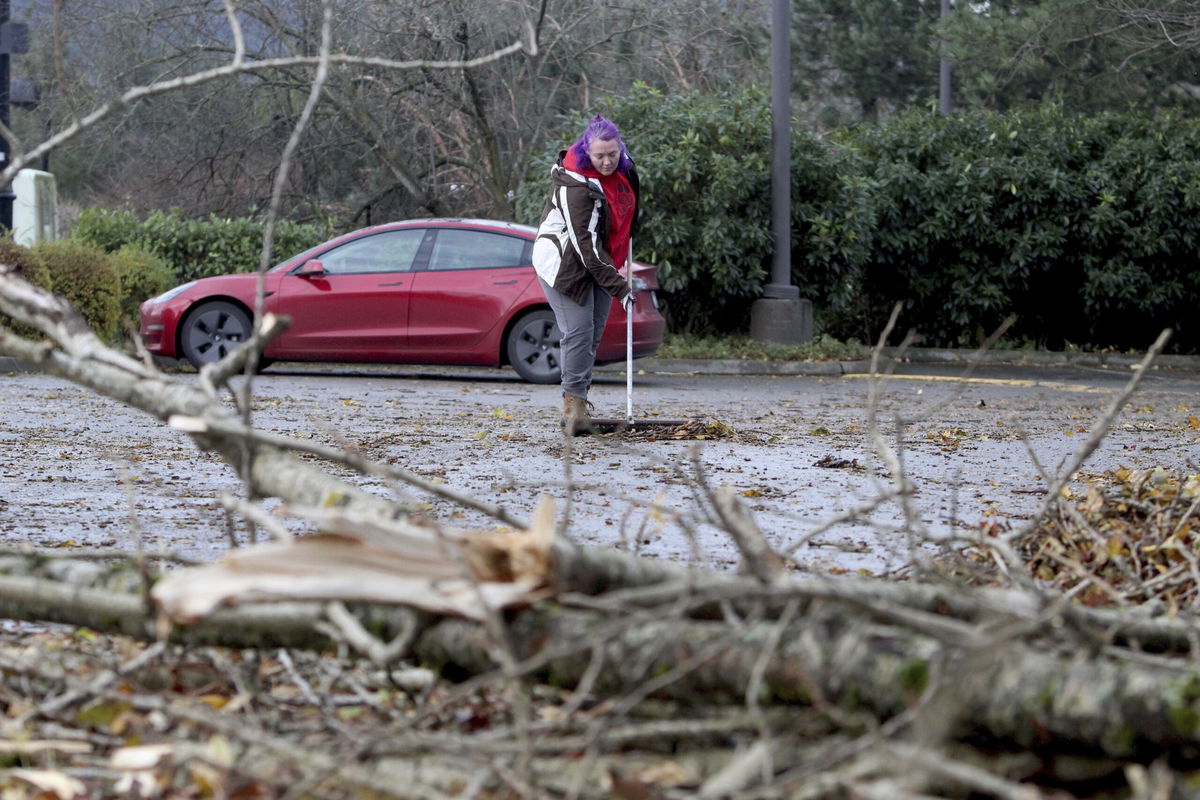A new storm is lashing areas hit by a deadly bomb cyclone and boosting an already prolific atmospheric river

Erica Leinbach cleans up debris from fallen trees after a bomb cyclone storm brought high winds to Issaquah
By Mary Gilbert, Karina Tsui and Robert Shackelford, CNN
(CNN) — A new storm impacting the Northwest could bring additional damage to the region following a historically strong bomb cyclone. It’s also adding another jolt of energy to an atmospheric river that’s already dumped nearly a foot and a half of rain on parts of California this week.
Gusty winds from the new storm will increase throughout the day in Washington, where more than 170,000 homes and businesses remain without power for the third day Friday, according to PowerOutage.us.
Hurricane-force winds from the bomb cyclone earlier this week battered parts of the state and knocked out power to more than half a million customers. At least two people were killed in Washington state from strong winds that felled trees. One, a woman in her 50s in Lynnwood, north of Seattle, and another – killed while showering in her King County home, according to the Bellevue Fire Department.
Some of the worst bomb cyclone damage occurred in King County, home to Seattle and its suburbs, according to Puget Sound Energy.
“The high winds and resulting tree damage not only downed the smaller, local power lines, but also damaged the larger transmission lines – the larger lines that bring power into communities,” PSE said in a post on X.
Wind gusts up to 30 mph from the new storm will roar through the Seattle area Friday afternoon, while gusts up to 60 mph are possible along Washington’s coast. These winds aren’t as strong as those generated by the earlier bomb cyclone, but soaked soil makes trees more unstable and susceptible to being felled by gusty winds.
“We are prepared to respond if there is new damage to the system,” a release from Puget Sound Energy said Thursday.
At the same time, a potent atmospheric river is pointing a firehose of moisture at Northern California.
A level 3 of 4 risk of flooding rainfall is in effect Friday for parts of the northern Sierra Nevada and the Coastal Range, just north of the San Francisco Bay Area, according to the Weather Prediction Center.
A third consecutive day of torrential rainfall will send this week’s rainfall totals skyrocketing. Nearly 18 inches of rain has fallen in parts of Northern California since Tuesday and an additional 5 to 10 inches of rain is possible into Saturday morning, according to the WPC.
Evacuation warnings were issued Friday in Humboldt County, California, over fears the county’s swollen rivers could impact homes. Officials urged anyone in the affected areas to be ready to evacuate quickly if conditions worsen.
Flooding forced road closures Thursday in Northern California’s Sonoma County, including its largest city, Santa Rosa, some 55 miles north of San Francisco, social media posts from state and local authorities show. Roads flooded in multiple locations, the fire department said Thursday evening, urging residents to “avoid unnecessary travel during this time.”
Approximately 150 people had to shelter in place at a medical center and a hotel in Santa Rosa because of flooding outside, Santa Rosa fire department chief Paul Lowenthal said Thursday.
About a dozen small landslides also struck Northern California in a 24-hour period earlier this week, including one on Highway 281 Wednesday morning that caused a vehicle crash, according to the Associated Press.
The heaviest rain this week has fallen just north of the San Francisco Bay area, but that changed late Friday morning.
“Widespread moderate to heavy rain will spread southeast across the rest of the Bay Area,” the National Weather Service in the San Francisco Bay Area cautioned Friday morning.
Heavy mountain snow in Northern California will also pick up again Friday and continue into early next week. An additional 1 to 4 feet of snow is expected by Tuesday, according to the National Weather Service.
More than a foot of snow buried parts of Northern California and the Cascade Mountains earlier this week.
CNN’s Rebekah Riess, Isaac Yee, Hanna Park, Sara Smart, Andy Rose, Mike Madrigal and Taylor Romine contributed to this report.
The-CNN-Wire
™ & © 2024 Cable News Network, Inc., a Warner Bros. Discovery Company. All rights reserved.